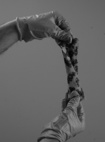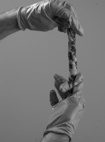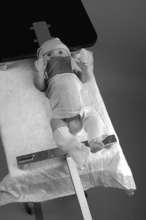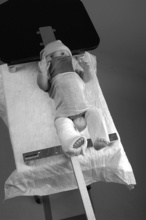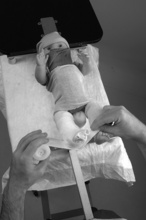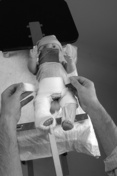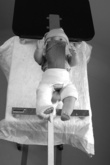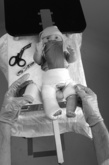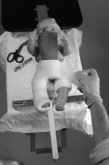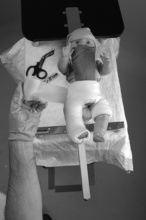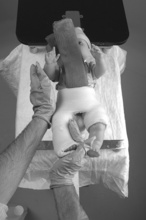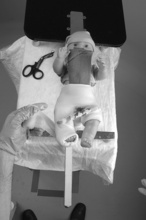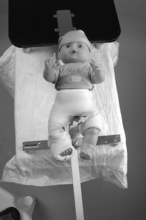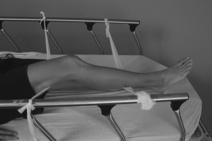Chapter 14 Lower Extremity Splints and Casts
Hip spica cast
Overview
2. The hip spica cast generally is composed of an abdominal portion attached to long leg casts, which is a so-called “double spica cast.” When the unaffected extremity is placed into a thigh-only cast, the cast is termed a “1½ spica cast.” A “single leg” hip spica cast is composed of an abdominal portion attached to a single long leg cast of the affected leg. All three types of spica casts have been shown to be successful in treating diaphyseal femoral fractures in children younger than 6 years.
Precautions
1. The following complications of hip spica casting may occur:
a. Compartment syndrome has been reported in the 1½ spica cast with the hip and knee flexed to 90 degrees.
b. Femoral and peroneal nerve palsy can occur, respectively, from excessive hip flexion and valgus molding over the fibular head.
2. Close monitoring of the patient for complications is necessary during the first 2 weeks after application of the cast.
3. Some authors argue that initial femoral shortening greater than 2 cm is a contraindication for treatment with a spica cast.
Pearls
1. We prefer a relaxed leg position with the knee at 60 degrees of flexion and the hip in 45 degrees of flexion rather than the traditional 90-90 position. An assistant should help the patient maintain this position throughout the application of the cast to avoid any bunching or creasing of the casting material.
2. Application of the cast can be performed in the emergency department with use of conscious sedation or in the operating room (OR) with use of general anesthesia.
3. Although they may not always be available, use of waterproof Gore-Tex pantaloons and a cast liner significantly improves the ability of the family to care for a child with a spica cast.
4. A broomstick, a twisted bar of fiberglass casting material, or some other connecting bar can be used to confer additional stability and strength to the spica cast.
Equipment
3. A stockinette, with the size depending on the size of the child; typically, a 2-inch stockinette is used for the leg portions and either a 3-, 4-, or 6-inch stockinette is used for the abdominal portion.
Basic Technique: 1½ Spica Cast
5. Steps:
d. Place two to four blue OR towels on the abdomen under the stockinette to allow for abdominal excursion after application of the cast.
g. Apply the abdominal portion of the spica cast and the contralateral thigh portion of the cast on the unaffected leg.
Detailed Technique
1. Prepare a stockinette:
a. Cut two pieces from a 2-inch stockinette:
(1) One piece is for the long-leg portion of the spica cast, measuring from the inguinal crease to 2 inches beyond the foot.
2. Place the patient on the spica table. Have an assistant consistently hold the patient in the desired position.
3. Position the stockinette (Figure 14-4):
a. Place the abdominal stockinette on the patient with the stockinette extending from the nipples to the mid thigh. Posteriorly, the stockinette should be placed over the spica table extension (i.e., the table should be in contact with the skin of the thoracic spine).
4. Place two to four blue OR towels on the abdomen under the stockinette to allow for abdominal excursion after application of the cast.
6. Wrap the extremity in cast padding (Figure 14-5).
a. Start at the gluteal fold and circumferentially wrap distally to the area immediately above the lateral malleolus.
b. Span the joint line with cast padding at the anterior aspect of the tibiotalar joint (see aforementioned precautions for the long leg cast).
e. Once sufficient padding has been wrapped around the malleoli and the foot, the heel can be addressed.
f. Tear strips of cast padding and lay them on top of the heel (Figure 14-6). Repeat several times to ensure sufficient padding.
7. Create a cast padding cuff (see Chapter 12) for the metatarsal heads. This cuff should form a “V” at the lateral aspect of the foot to allow for the cascade of the digits (Figure 14-7).
8. Wrap the abdomen in cast padding (Figure 14-8). Ensure that the anterior superior iliac spine, posterior superior iliac spine, and sacrum are very well padded.
9. Wrap the contralateral thigh in cast padding. Start immediately proximal to the popliteal fossa and continue proximally to the gluteal fold.
10. Create a cuff of cast padding (Figure 14-9) and place it over the most distal part of the rib cage.
12. Finish the cast edges (Figure 14-10). All exposed areas should have the stockinette pulled up and folded over the cast padding.
14. Apply cast material as for a long leg cast.
b. Ensure that a significant amount of stockinette and cast padding remains to the level of the gluteal fold (Figure 14-11).
15. Begin application of the abdominal portion of the spica cast and the contralateral thigh portion of the cast for the unaffected leg.
b. Carefully incorporate only the unaffected leg into the abdominal portion, using a figure-of-8 technique around the hip (Figure 14-12).
19. Create a side strut for the affected extremity if plaster is being used.
a. Take a roll of plaster and create a splint that is 10 layers thick extending from the mid abdomen to the mid thigh.
20. Apply a broomstick or bar of fiberglass to span both legs. Incorporate the strut and the bar into the spica cast with an additional roll of fiberglass (Figure 14-15).
Long-leg splint
Precautions
1. As in any other splint that immobilizes the ankle and foot, the position of the foot within the splint is of paramount importance. Do not allow the foot to be in equinus except in the case of very distal tibial shaft fractures where dorsiflexion results in extension at the fracture site.
Pearls
1. Before starting, ensure that adequate analgesia has been achieved, either with intravenous opioids or conscious sedation.
2. The long-leg splint is one of the most difficult splints to apply; having the aid of two assistants facilitates the process. If help is not available, use either the technique described below or this alternative method to elevate the limb (Figure 14-17):
d. Lay one roll of rolled gauze under the patient’s thigh and the other under the calf, with equal lengths on each side of the limb.
3. It is recommended that cool water be used (to delay plaster setting) and that all three plaster slabs be prepared in water prior to application of the splint. This approach reduces the amount of time the patient needs to be elevated and thus reduces patient discomfort. It also reduces the amount of work that needs to be done by the assistants.
4. For high-energy injuries, we prefer to use Jones’ cotton in place of regular cotton cast padding.
5. Use of a “mega-ACE” bandage that is 11 yards long makes securing this splint much more manageable because it eliminates the need for multiple elastic bandages.
6. Premade 45-inch plaster slabs typically are an appropriate length for all three slabs necessary for this splint.
Detailed Technique
3. Prepare the plaster in the usual fashion. Use the standard technique of wetting and laminating (see Chapter 12).
4. Place a padded crutch beneath the mattress on the stretcher so that only a foot of the top of the stretcher remains visible (Figure 14-20).
5. Position the patient:
a. The patient is supine with his or her pelvis halfway onto the crutch (Figure 14-21). Make sure the patient and the crutch are secure.
b. Allow the limb to hang down, or support it by placing the patient’s foot on your thigh (Figure 14-22). If assistants are available, they can elevate the limb.
6. Apply Jones’ cotton or regular cast padding (Figure 14-23):
a. If using Jones’ cotton, start at metatarsal heads and wrap in a circumferential fashion proximally to the mid thigh with minimal overlap.
7. Apply the splint.
a. Begin with the posterior slab:
(2) Provisionally secure the splint with cast padding at the knee and then the thigh (Figure 14-24).
